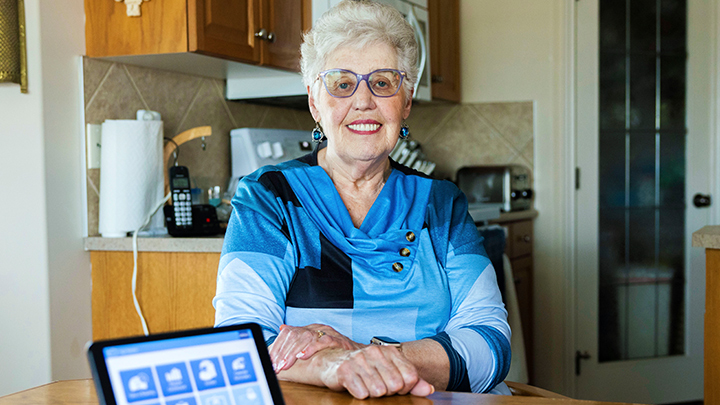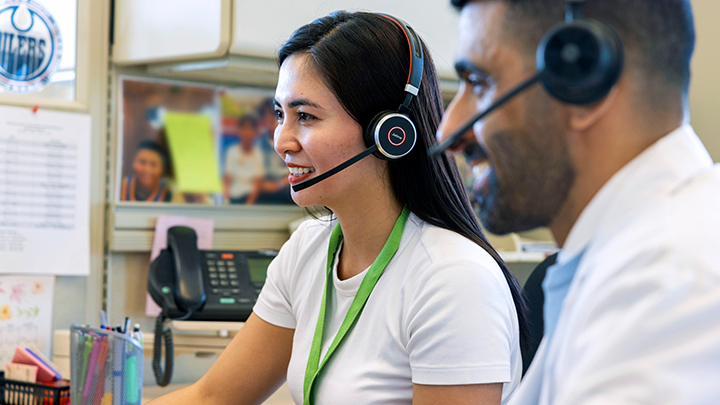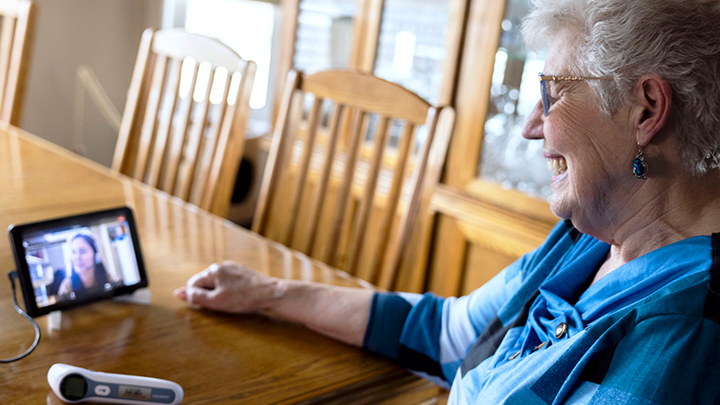
May 2, 2024

Inge Westlin, 77, was a patient of the Edmonton Zone Virtual Home Hospital’s (EZVHH) cardiology unit while she waited for a cardiac ablation procedure. Thanks to this virtual care, she was able to wait in the comfort of her home rather than in the hospital. Photo by Evan Isbister.

Dr. Nawaf Almajed, cardiology medical lead for the EZVHH, and Abigail Sumagit, a registered nurse with the EZVHH, stay connected to Inge by using digital patient monitoring. Photo by Evan Isbister.

Registered nurse Abigail Sumagit (on screen) and patient Inge Westlin connect virtually using one of the virtual tools provided by the EZVHH. Virtual check-ins by members of the care team with their patients are key to staying connected throughout a patient’s care journey. Photo by Evan Isbister.
Story by Katie McLaughlin | Photos by Evan Isbister
Inge Westlin, a spry 77-year-old Leduc resident, woke up one morning last July feeling unwell. Her heart was racing, her blood pressure was high, her energy low and she felt an unfamiliar fluttering in her chest. This was a new — and scary — feeling.
“I’ve never had heart issues before, but I had just recovered from a cold that turned into bronchitis,” says Westlin. “Suddenly, I developed a heart flutter and felt unwell. I was advised to go to the emergency department.”
There, they were able to restore a heart rhythm. But her heart problems returned shortly after she returned home.
“One day, my heart rate was so rapid that I thought I was going to have a heart attack,” she adds.
Westlin was taken by ambulance to the Mazankowski Alberta Heart Institute and admitted. That’s when Dr. Nawaf Almajed, an associate clinical professor and cardiologist with Alberta Health Services (AHS) and the cardiology medical lead for the Edmonton Zone Virtual Home Hospital (EZVHH), came into the picture.
“Inge was admitted for an atrial flutter and heart failure,” says Dr. Almajed. “Given that her atrial flutter kept coming back several times, I eventually recommended she have an ablation done, which is a procedure that helps block the irregular electrical signals that cause a flutter, restoring a regular heartbeat. I knew she could safely be at home while she waited for her procedure if she was monitored by a care team.”
Westlin was discharged from the hospital into the care of the EZVHH cardiology unit. She was sent home with a digital patient monitoring kit that allows her care team, including Dr. Almajed, to remotely monitor vitals such as her blood pressure and heart rate.
“We use the ever-evolving power of technology to provide acute-level care to patients while in the comfort of their own homes,” says Lisa Marco, patient care manager for the EZVHH. “A patient is provided digital tools that allow us to monitor them remotely, enabling them to leave the hospital early or avoid an inpatient hospital admission altogether. The virtual hospital allows patients to continue to receive safe, high-quality care, while still having the support of a multidisciplinary healthcare team right at their fingertips.”
Virtual Home Hospital care teams include healthcare professionals such as doctors, nurses, nurse practitioners, pharmacists and any other healthcare professional a patient might need during their care, including a patient’s primary care provider, if they have one.
“Inge was referred to our program so we could monitor her heart,” says Abigail Sumagit, a registered nurse with the EZVHH. “We were able to provide care and monitoring, so she didn’t end up back in the emergency department while waiting for her procedure.”
While most of Westlin’s care was virtual, she had one in-person assessment after her virtual care team noticed something was off with her vitals.
“We called the community paramedics, who partner with us to provide in-home care to our patients when required, and asked them to visit Inge and do an assessment,” adds Sumagit. “The paramedics went to her house and did an electrocardiogram and drew some blood. We followed up with her virtually.”
Westlin was able to safely return to many of her usual daily activities while she waited for her ablation, all thanks to the remote monitoring provided by the EZVHH. She did her digital readings and connected with her care team without having to stay in the hospital.
“The program felt like a cradle of love,” says Westlin, who’s been free of heart-related symptoms since her ablation in August. “It felt like I had a lifeline during a very stressful time. If you have to be sick, it’s nice to know that you have the care you need. If I had questions or concerns, I knew the team was a phone call away.”
Virtual Home Hospital doctors stay connected to patients through regular reports from the care team, or direct patient contact. If a patient’s condition changes, the care team can arrange to have them sent for further diagnostic tests, lab work or other procedures they may need. The care team can also connect patients with community resources to help them, such as Home Care services and dietitians. They also focus on educating patients about their health, so they can be more involved in their ongoing care.
AHS’ Virtual Home Hospital program has been safely providing care to Albertans with high patient-satisfaction rates since 2018. The program is currently offered in the Calgary and Edmonton area, with expansion to other parts of the province planned.
“Virtual Home Hospital is a great example of an innovative model that allows us to care for certain patients safely and effectively while they’re at home,” says Dr. Almajed. “It has the potential to reduce strain on brick-and-mortar hospitals by offering remote diagnostics and treatment. There’s potential for more patient populations to be part of this program.
“We’re also looking at incorporating new technologies, like the ability to monitor a patient’s heart rhythm remotely. I’m excited about the future of Virtual Home Hospital.”
Learn more about the Virtual Home Hospital.